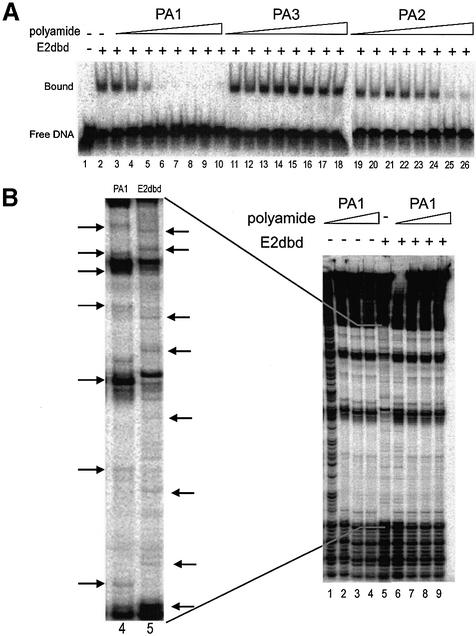Figure 4.
Competition experiments with E2dbd and polyamides. (A) EMSA was performed with a radiolabeled HPV E2 BS4 probe in reactions lacking E2dbd (lane 1) or containing a constant concentration of E2dbd (10 nM; lanes 2–25). Reactions were supplemented with the vehicle DMSO (lane 2) or polyamide PA1 (lanes 3–10), PA3 (lanes 11–18) or PA2 (lanes 19–26) diluted in DMSO. Polyamide concentrations tested were 0.13 (lanes 3, 11 and 19), 0.64 (lanes 4, 12 and 20), 3.2 (lanes 5, 13 and 21), 16 (lanes 6, 14 and 22), 80 (lanes 7, 15 and 23) and 400 nM (lanes 8, 16 and 24) and 2 (lanes 9, 17 and 25) and 10 µM (lanes 10, 18 and 26). (B) Quantitative DNase I footprinting assays were performed with the radiolabeled restriction fragment described in the legend to Figure 2. Reactions were performed in the absence of E2dbd (lanes 1–4) or in the presence of a constant concentration of E2dbd (lanes 5–9). Polyamide PA1 was titrated at the following concentrations: 0 (lane 5), 0.1 (lanes 1 and 6), 1 (lanes 2 and 7), 10 (lanes 3 and 8) and 100 nM (lanes 4 and 9). A magnification of lanes 4 and 5 in the main autoradiogram is shown as an inset to the left. Horizontal arrows indicate unique hypersensitivity bands characteristic of polyamide PA1 binding (lane 4) or E2dbd binding (lane 5) to a BS4 DNA site.

